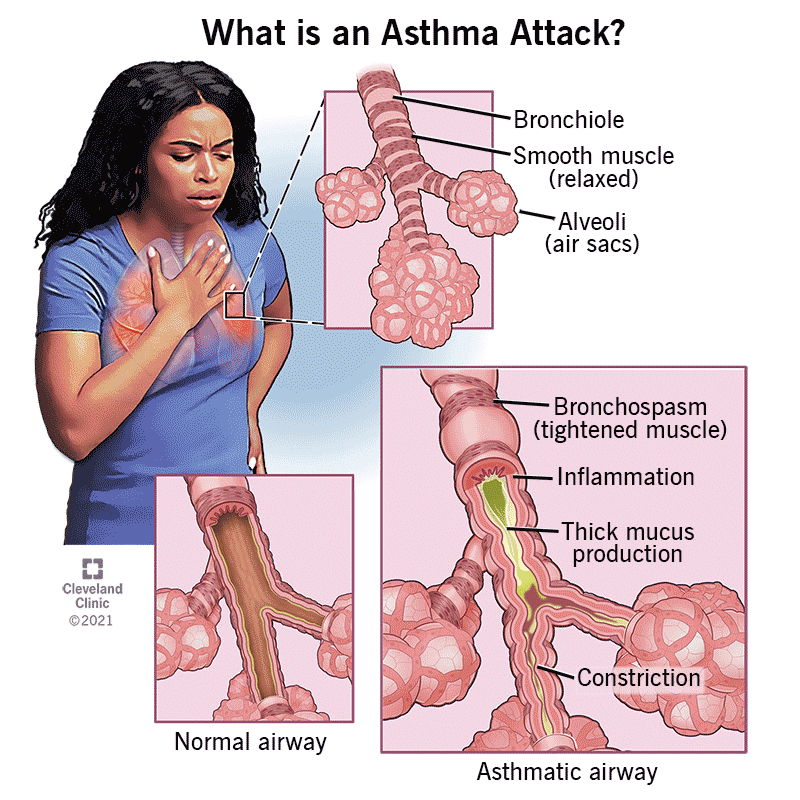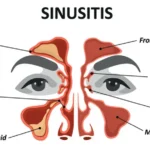An acute asthma attack, also known as an exacerbation, is a sudden worsening of asthma symptoms caused by tightening of airway muscles, inflammation, and excessive mucus production. Timely intervention during an asthma attack is crucial to prevent life-threatening complications. This article provides detailed insights into the causes, symptoms, emergency response measures, and long-term prevention strategies for acute asthma attacks.

What Is an Acute Asthma Attack?
An acute asthma attack occurs when the airways narrow and become inflamed, restricting airflow to the lungs. These episodes can vary in severity and often require immediate treatment. Common triggers include allergens, respiratory infections, air pollution, exercise, and emotional stress.
Symptoms of an Acute Asthma Attack
Recognizing the signs of an acute asthma attack is essential for prompt intervention. Symptoms include:
- Severe shortness of breath, even at rest
- Chest tightness or pressure
- Rapid breathing (tachypnea)
- Persistent wheezing
- Difficulty speaking or completing sentences
- Bluish discoloration of lips or fingernails (cyanosis)
- Increased heart rate (tachycardia)
If left untreated, an acute asthma attack can escalate into a life-threatening situation requiring emergency medical attention.
Causes and Common Triggers of Acute Asthma Attacks
Understanding the underlying causes of asthma exacerbations helps in managing and preventing them effectively. Common triggers include:
- Allergens: Dust mites, pollen, pet dander, and mold.
- Respiratory Infections: Viral infections like colds and the flu.
- Irritants: Smoke, strong odors, and chemical fumes.
- Weather Changes: Cold air or sudden changes in temperature.
- Exercise: Particularly in cold or dry environments.
- Stress: Emotional stress or anxiety can trigger attacks.
Emergency Response for an Acute Asthma Attack
Immediate action during an asthma attack can save lives. Follow these steps for effective management:
1. Use a Quick-Relief Inhaler
Administer two to four puffs of a short-acting beta-agonist (SABA) like albuterol. Repeat every 20 minutes for up to an hour if symptoms persist.
2. Sit in an Upright Position
Sitting upright can improve airflow and ease breathing.
3. Loosen Tight Clothing
Remove any restrictive clothing around the neck or chest.
4. Stay Calm and Focused
Panic can worsen symptoms. Encourage the individual to remain calm and practice controlled breathing.
5. Seek Medical Attention
If symptoms do not improve after using a quick-relief inhaler, call emergency services or go to the nearest hospital.
Long-Term Strategies for Managing Acute Asthma Attacks
Preventing acute asthma attacks requires a proactive approach involving medication adherence, lifestyle modifications, and regular monitoring.
1. Asthma Action Plan
Work with your healthcare provider to create a personalized asthma action plan. This document outlines steps for daily management and emergency responses.
2. Maintenance Medications
Inhaled corticosteroids, long-acting beta-agonists (LABAs), and leukotriene modifiers help reduce inflammation and prevent attacks.
3. Trigger Avoidance
Identify and avoid specific triggers. Use air purifiers, practice good hygiene, and minimize exposure to known allergens.
4. Regular Monitoring
Use a peak flow meter to monitor lung function and detect early signs of worsening asthma.
5. Vaccinations
Stay up-to-date with flu and pneumonia vaccines to reduce the risk of respiratory infections.
Recognizing Severe Asthma Exacerbations
Severe asthma attacks may not respond to typical treatments and require advanced medical interventions, such as:
- Oxygen Therapy: To maintain adequate oxygen levels.
- Nebulizer Treatments: Delivery of medications through a mist for deeper airway penetration.
- Systemic Corticosteroids: Oral or intravenous steroids to reduce severe inflammation.
Prompt treatment at this stage is vital to prevent respiratory failure.
Acute asthma attacks are medical emergencies that demand immediate attention and comprehensive management strategies. By recognizing symptoms early, avoiding triggers, and adhering to prescribed treatments, individuals can minimize the frequency and severity of asthma exacerbations. Regular check-ups and personalized asthma action plans further empower patients to lead healthier lives.

